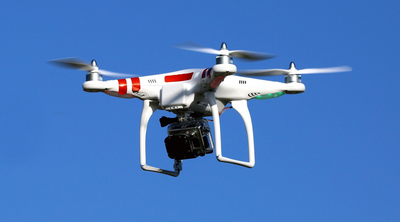Precision flight control, the importance of IMU in UAVs

Nowadays, the use of drones is more and more extensive, such as agricultural monitoring, express delivery, environmental protection, urban planning, etc., many industries have to rely on the efficiency and flexibility of drones to help. The precise Flight Control (Flight Control) system is particularly key, and the Inertial Measurement Unit (IMU), as one of the core components of the flight control system, plays a crucial role.
The basic principle of MU
IMU is a high-tech sensor device that can figure out the UAV's attitude, speed and acceleration information in three-dimensional space in real time. It usually consists of several sensors, such as a gyroscope, an accelerometer, and sometimes a magnetometer. The gyroscope is used to measure the angular speed, which can help determine the direction and rotation of the drone; What about accelerometers? They're designed to detect linear acceleration, so they can figure out how the drone's speed is changing. When this data is combined, the IMU can give us the absolute position and dynamic state of the drone relative to the ground. This information is very useful, not only for flight control, but also for things like course planning, obstacle avoidance and stable flight.
The need for precise positioning
When the UAV flies, accurate space positioning is the key to ensure flight safety and mission success. By constantly updating the position information of the UAV, the IMU can provide particularly important data support to the flight control system. Whether performing highly automated tasks or flying in complex environments, the IMU helps the drone stay on its intended flight path. In an agricultural spraying operation, for example, drones must fly precisely at a predetermined route and altitude to ensure that pesticides are evenly applied. In this application, the IMU data integrates meteorological conditions, wind speed and load changes, so that the UAV can adjust its flying attitude, so that it can achieve high precision operation!
Also, in practical applications, external environmental influences, such as wind disturbances and sudden climate changes, often make the flying state of the drone unstable. At this time, the IMU plays a role of "motion compensation". It can monitor the motion state of the UAV by immediately collecting real-time data, and then quickly feed back to the flight control system, so that the flight control system can adjust automatically. In addition, the IMU is particularly important for the attitude control mechanism of the UAV. Maintaining a steady attitude during flight is very important, especially when doing complex maneuvers or high speed maneuvers. By monitoring the rotation of the UAV, the IMU can quickly detect any attitude change that may lead to loss of control, and then correct it through the corresponding control algorithm. This not only improves the safety of the flight, but also makes the operation of the drone more flexible!
In modern unmanned aerial systems, IMU data is also fused with other types of HY27UU088G2M sensor data, such as Global Positioning systems (GPS) and vision sensors. This data fusion technology can make the positioning accuracy and stability of the drone to a higher level. For example, when the GPS signal is interfered with or the signal is weak, the IMU can also provide real-time motion data support to help the drone continue to fly stably.
By fusing multi-sensor data, the flight control system can implement more complex algorithms, such as Kalman filtering, which is especially useful for extracting optimal state information from different sensors, from high-speed flight to short hovering. Such a system can make UAVs have better adaptability and stability in a variety of complex environments.
In UAV flight control applications, this IMU not only requires high precision, but also real-time is particularly important. When a drone is in the air, the situation can change quickly, and the IMU has to collect data at very high frequencies, often in the hundreds of Hertz, to ensure that the flight control system can react quickly and adjust. This requires the IMU to be designed with high sampling rate and low latency. For example, in high-speed flight or maneuvering flight, the large yaw Angle change and instantaneous acceleration will have a significant impact on steady-state flight, at this time, the data processing ability of IMU is particularly critical. The data updated every millisecond could have a direct impact on the safety of the drone.
IMU reliability and durability
Drones often work in harsh environments, such as hot, cold, wet or dusty places. Therefore, the reliability and durability of the IMU must be carefully considered when designing. A good quality IMU must have good sealing characteristics, cannot allow dust and moisture to enter, and must be able to work properly under extreme temperatures and vibrations.
In general, the commercial-grade IMU products have to go through a very strict tolerance test, such as vibration test, environmental aging test, in order to ensure that they can be stable in actual operation. These tests not only provide users with a more reliable operating experience, but also lay the foundation for integrated operational safety of UAVs.
In the future, IMU as one of the core technologies of UAV precise flight control system, that role can be too great. By sensing and integrating multidimensional motion state information, IMU can ensure that the UAV can fly safely, efficiently and stably in a variety of complex environments. Whether in terms of technological innovation, or in practical applications, the continuous progress of IMU will further promote the development of the drone industry. In the future, the application prospect of IMU is even broader.
관심을 가질만한 제품
 |
AMI-M11O-1-6-B | LINE FILTER 250VAC 6A CHASS MNT | 5184 More on Order |
 |
AMI-28B-16-3 | LINE FILTER 110/250VAC 16A CHAS | 7560 More on Order |
 |
AMI-M12R-1-1-B-1 | LINE FILTER 250VAC 1A CHASS MNT | 8856 More on Order |
 |
AMI-M12B-1-12-B | LINE FILTER 250VAC 12A CHASS MNT | 7362 More on Order |
 |
AMI-M12B-3-7-B | LINE FILTER 250VAC 3A CHASS MNT | 8226 More on Order |
 |
AMI-M12M-8-3-B | LINE FILTER 250VAC 8A CHASS MNT | 8442 More on Order |
 |
AMI-M12Y-6-20-C | LINE FILTER 250VAC 20A CHASS MNT | 6966 More on Order |
 |
AMI-M11O-1-20-C | LINE FILTER 250VAC 1A CHASS MNT | 2682 More on Order |
 |
AMI-M12S-7M-5-B-2 | LINE FILTER 250VAC 7A CHASS MNT | 5184 More on Order |
 |
AMI-M12AI-3-0.5-B | LINE FILTER 250VAC 3A CHASS MNT | 8694 More on Order |
 |
AMI-M11A-1-5-B | LINE FILTER 250VAC 5A CHASS MNT | 2286 More on Order |
 |
AMI-B11C-13-1-B-2 | LINE FILTER 250VAC 1A CHASS MNT | 3330 More on Order |
 |
AMI-M11UC-1-16-C | LINE FILTER 250VAC 1A CHASS MNT | 3436 More on Order |
 |
AMI-M12Y-1-20-D | LINE FILTER 250VAC 20A CHASS MNT | 4212 More on Order |
 |
AMI-M11P-6-20-C | LINE FILTER 250VAC 20A CHASS MNT | 7596 More on Order |
 |
AMI-21B-20-1 | LINE FILTER 250VAC 20A CHASS MNT | 5022 More on Order |
 |
AMI-M12W-1-10-C | LINE FILTER 250VAC 10A CHASS MNT | 3400 More on Order |
 |
AMI-29B-3-1 | LINE FILTER 110/250VAC 3A CHAS | 4698 More on Order |
 |
AMI-M11A-6-10-D | LINE FILTER 250VAC 10A CHASS MNT | 5526 More on Order |
 |
AMI-29A-1-1 | LINE FILTER 110/250VAC 1A CHAS | 3690 More on Order |
 |
AMI-21-16-3 | LINE FILTER 250VAC 16A CHASS MNT | 7344 More on Order |
 |
AMI-22-3-1 | LINE FILTER 250VAC 3A CHASS MNT | 7560 More on Order |
 |
AMI-22B-1-1 | LINE FILTER 250VAC 1A CHASS MNT | 2916 More on Order |
 |
AEV250-MA | RELAY CONTACTOR SPST 250A 36V | 3978 More on Order |









